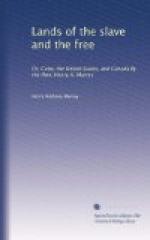The only real object of interest at Norfolk is the dockyard, which of course I visited. Mr. James was kind enough to accompany me, and it is needless to say we were treated with the utmost courtesy, and every facility afforded us for seeing everything of interest, after which we enjoyed an excellent lunch at the superintendent’s. They were building a splendid frigate, intended to carry 58-inch guns; her length was 250 feet, and her breadth of beam 48. Whether the manifest advantages of steam will induce them to change her into a screw frigate, I cannot say. The dockyard was very clean and the buildings airy. Steam, saw-mills, &c., were in full play, and anchors forging under Nasmyth’s hammer, I found them making large masts of four pieces—one length and no scarfings—the root part of the tree forming the mast-head, and a very large air-hole running up and down the centre. The object of this air-hole is to allow the mast to season itself; the reader may remember that the mast of the “Black Maria” is made the same way. As far as I know, this is a plan we have not yet tried in our dockyards. I find that they use metallic boats far more than we do. I saw some that had returned after being four years in commission, which were perfectly sound. To say that I saw fine boats and spars here, would be like a traveller remarking he saw a great many coals at Newcastle. All waste wood not used in the yard is given away every Saturday to any old woman who will come and take it; and no searching of people employed in the dockyard is ever thought of. The cattle employed in and for the dockyard have a most splendid airy stable, and are kept as neat and clean as if in a drawing-room. Materials are abundant; but naturally there is little bustle and activity when compared to that which exists in a British yard. Their small navy can hardly find them enough work to keep their “hands in;” but doubtless the first knell of the accursed tocsin of war, while it gave them enough to do, would soon fill their dockyards with able and willing hands to do it. Commodore Ringold’s surveying expedition, consisting of a corvette, schooner, steamer, &c., was fitting out for service, and most liberally and admirably were they supplied with all requisites and comforts for their important duties.
During my stay I enjoyed the kind hospitalities of our consul, Mr. G.P.E. James, who is so well known to the literary world. He was indulging the good people of Norfolk with lectures, which seem to be all the fashion with the Anglo-Saxon race wherever they are gathered together. The subject which I heard him treat of was “The Novelists,” handling some favourites with severity and others with a gentler touch, and winding up with a glowing and just eulogy upon the author of My Novel. Altogether I spent a very pleasant hour and a half.




